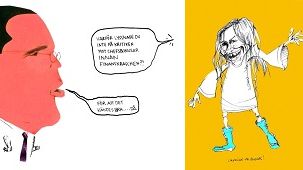
Press release -
Accomplished artists in caricature exhibition
Next spring and summer, Nationalmuseum will be showing The Art of Exaggeration – Caricature in Sweden. The exhibition follows the development of Swedish caricature art through the ages, from the private sphere to a public position that echoes around the world. Recently caricature and cartoons have once again become the burning issue that they were two hundred years ago.
The key element of a caricature is that it captures the features and body language of a recognisable figure, whether in a humorous situation or not. This means that it may be done in jest, but is not always the case. It makes its point by exaggerating typical and peculiar characteristics without going too far and turning into bullying and defamation.
The caricature became popular in the 17th century due to its emotive subjects and visual gags. At that time, it was a more private affair, since there were limited options for publication, with the drawings appearing in letters and diaries. However, the new printing technologies of the 18th century made mass printing possible and brought the caricature into the public arena. With the growth of the picture press in the 19th century, the caricature became a powerful symbol and being caricatured started to be seen as a sign of celebrity status. The lithographic technique also enabled a more personal drawing style and a level of artistry that set the standard for all caricature art to come.
Making fun of powerful people has not always been entirely risk-free. Up until the mid 19th century, cartoonists in Sweden could still be sentenced to death for their caricatures. The early 20th century saw female artists start to make a name for themselves, particularly in the field of theatrical caricature. After a period in which it had chiefly appeared as political comment on the editorial pages of the daily newspapers, the caricature once again became a burning issue in 2005. This was the year that Denmark’s Jyllands-Posten published the cartoons of the prophet Mohammed that prompted such strong reactions around the globe.
The exhibition shows around 90 drawings, prints and digital images by Swedish artists from the 16th century to the present day. It is a mix of works from Nationalmuseum’s own collection and works on loan. The artists on display include Johan Tobias Sergel, Carl August Ehrensvärd, Gustaf Wahlbom, Albert Engström, EWK, Annie Bergman and Stina Eidem.
Extra information
- The caricature is rooted in two major academic traditions, since it features in the physiognomy and anatomy studies of both the art establishment and the science world.
- Parallels have often been drawn between the expression of human emotion and the way that animals behave.
- Gustav IV Adolf was the first Swedish king to become a mass-media figure.
- Philosopher and campaigner Ellen Key was the most caricatured women of her time in Sweden.
- In the mid-19th century, one use of the caricature was to spread anti-Semitic propaganda.
- A caricature could lead to execution during the first decades of the 19th century.
The exhibition will run from 8 March to 12 August 2012 in the Gallery on the entrance level, where admission is free. Over the same period up on level 2, the exhibition Passions will look at how emotions are interpreted and depicted in art.
Further information
Lena Johannesson, exhibition curator, lajn@nationalmuseum.se
Ulf Cederlöf, exhibition curator, ucf@nationalmuseum.se, +46 8 5195 4402
Hanna Tottmar, press officer, htr@nationalmuseum.se, +46 8 5195 4390
Press images
www.nationalmuseum.se/pressroom
Captions
Martin Lamm, Birgit Nilsson sings, © Musik- och teatermuseet; Magnus Bard, Minister for Finance Anders Borg, © Magnus Bard; Helena Lindholm, Caroline af Ugglas, © Helena Lindholm
Categories

